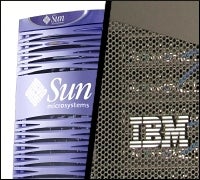|
|
Wednesday’s report in the Wall Street Journal that IBM was in talks to purchase Sun Microsystems livened up what had otherwise threatened to be a dull day.
Overlapping products and vastly different cultures present challenges. But if they make it stick, the results could be great for both sides.
Once the initial shock wore off, however, industry watchers had to weigh the obvious questions regarding the potential of such a merger.
The news propelled Sun’s stock up 80 percent in daily trading, with volume 10 times normal daily averages. Sun’s stock had fallen so low its book value of $6.6 billion was actually less than its total assets of $7.7 billion.
Neither company responded to requests for comment.
The two firms seem an unlikely pairing — because they are both so much alike, and still so different. Both feature non-x86 proprietary server processors: IBM with its Power processor and Sun with its UltraSparc line. Sun’s Solaris operating system runs on x86 processors, and IBM has certified and supports Solaris it on its blade servers.
Both have high-end tape storage products. Both support Linux and have their own flavor of Unix, although Sun also puts its Unix, Solaris, on x86. IBM’s AIX is only for the Power processor.
More notably, both firms are in the Java business. Sun invented it but IBM practically subsumed it with the Eclipse Project, an industry-wide Java effort that tweaked Sun even by its very name — a solar eclipse is the blocking of the sun, after all.
A merger of these two firms might unify Java in a way it badly needs, with competition from rich Internet application (RIA) projects like Adobe’s AIR and Microsoft Silverlight.
Still, the deal is not without its skeptics.
“The rumor is IBM is buying Sun because they want their server business, but IBM is already killing Sun in the server business,” said Andi Mann, senior analyst with Enterprise Management Associates. “It’s not what ‘IBM’ normally do. They don’t buy market; they buy technology.”
But Matt Eastwood, group vice president of IDC’s Enterprise Platform Group, thinks the merger makes sense, should it indeed go through. IBM has a decent Unix business and has eaten into Sun’s share, but Sun is still leader there.
“What IBM really wants to do is drive more volume for Power-based systems, so here’s a chance for them to acquire Sun and the Solaris assets, port it to Power, and drive Power-based hardware into Sun accounts and wrap more IBM value around it, IBM software and service and finance offerings,” he told InternetNews.com.
IBM would not abandon its AIX operating system, and it would take years to bring Solaris to Power. IBM wouldn’t abandon AIX for many years, and Sun would likely have to support its hardware partner Fujitsu, which sells UltraSparc-based servers. So no platforms would be abandoned in the short-term.
Sun has three good businesses in open storage, its chip multithreading (CMT) servers and is making progress in x86. But that’s not offsetting slowing in other areas, said Eastwood, nor has Sun monetized its software assets very well.
“What you have is a company, Sun, that’s much better positioned than they’ve been, but is hitting the wall in terms of the conditions of the market,” said Eastwood. “Conditions are awful, people are pulling back. Not that people expect Sun to go away, but I think there are serious concerns about Sun’s ability to innovate and invest for the long-term.”
The T-Shirts Meet the Suits
The big challenge of the two firms will likely be cultural. IBM isn’t as buttoned down as it once was, but it’s nowhere near as casual as Sun, where shirts with collars are rarely seen beyond the senior executive offices.
|
|
| Sun CEO Jonathan Schwartz (left) and IBM CEO Sam Palmisano Sources: Sun Microsystems and IBM |
“They are very different cultures and I don’t see a tremendous amount of compatibility there,” Eastwood said. But he added that IBM has maintained a really strong engineering culture inside its acquired companies, even though IBM itself is viewed as a “blue-chip business company run by a bunch of suits.”
IBM has made a number of sizable software purchases, such as WebSphere, Lotus, Rational and Tivoli, and managed to preserve those products. “From what I see, IBM has done a great job of incorporating software companies into their umbrella,” Eastwood said.
But Mann thinks it will be tough for both firms — just consider Sun’s ponytailed CEO, Jonathan Schwartz, and IBM’s buttoned-down chief executive, Sam Palmisano.
“Look at Palmisano versus Schwartz. Can you see these guys playing racketball at the club?” Mann joked.
“I think the problem goes further down the chain, too, because Big Blue is still a staid organization,” he added. “There are a lot of suits and they do things very ponderously, very definitively, whereas Sun is an experimenter that goes out on limbs and fails occasionally.”
Mann said his worry had been that Sun would continue its slide and be sold off in pieces. “I never thought they would be swallowed whole like this, if it does go through,” he said.
Eastwood, too, said he was glad Sun would continue on, at least in some form.
“The marketplace without Sun would be much less interesting, because they are quite innovative and do things differently,” he said. “But where IBM could take Sun and take Sun’s technology — I think it’s good.”
This article was originally published on InternetNews.com.




